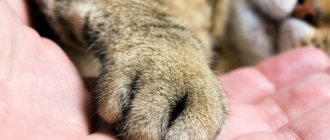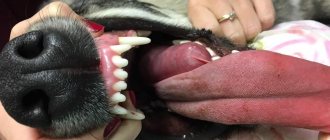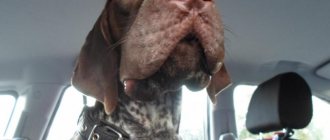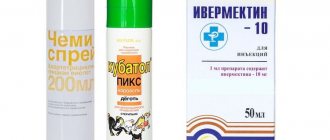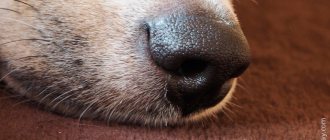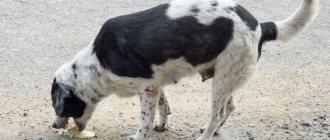Answer
Small puppies are very active and often get confused under their owner’s feet. There are often cases when owners accidentally step on their pets. Sometimes this is just a matter of fear, but sometimes it can lead to serious consequences, including death.
Pinching a puppy's limbs can result in:
- Injury;
- Dislocation;
- Fracture.
The symptoms of a bruise can be easily relieved on your own, but for dislocations and fractures, professional veterinary care will be required. You cannot take an injury lightly, otherwise the dog may remain lame for life or even die.
If the puppy has been limping for several days or has stopped getting up, you must urgently go to a veterinary clinic and take an x-ray of the damaged limb.
Types and dosage of pain medications
Pain medications for dogs can be systemic or local. Painkillers for animals are not very common on the Russian veterinary pharmaceutical market, and they cannot be purchased in every city. But in large cities there are specialized veterinary pharmacies and clinics where you can consult and buy painkillers for dogs.
Painkillers for all types of animals, as well as for people, are divided into two types:
- local analgesics;
- systemic analgesics.
Local painkillers are used directly at the site of pain. Systemic drugs have a general effect, suppressing pain symptoms throughout the animal’s body.
Injury
A bruise is characterized by swelling of soft tissues, hematomas, and bruises. This occurs due to internal hemorrhage occurring as a result of the contusion. The bruised area is painful: the dog may bend its leg when walking, limp, or lick the sore spot. However, these symptoms pass fairly quickly.
To treat a bruise, apply ice to the injury. And to relieve pain, apply a bandage with anti-inflammatory ointment.
If your puppy stops walking, he probably has an injury more serious than a bruise. During the period of skeleton formation, puppies have fragile bones that are easily damaged.
Wounds and bleeding
A wound is one of the most common injuries in dogs. Most often, this term refers to any injury accompanied by damage to the skin. Bleeding almost always begins when the dog is injured, but sometimes it can appear later - this is typical, for example, of injuries received in a fight with other animals.
According to the type of application and the nature of damage to the skin and tissues, wounds are divided into:
- Biting is a consequence of a fight with another dog or cat.
- Torn - can be obtained in a fight or due to severe damage. They are characterized by significant size, profuse bleeding and tearing off flaps of skin. Injuries to claws in dogs that are excessively long can also be accompanied by lacerations: the claw, acting as a lever, simply tears off the skin and injures blood vessels.
- Cuts - dogs most often get them by stepping on glass or other sharp objects. Accordingly, the paw pads are usually affected, and the extent of the damage directly depends on the dog’s weight.
- Split - characterized by a small area and large depth of penetration. This often happens if the dog runs into a nail or sharp object. Most cases affect the trunk rather than the limbs. The main danger of a puncture wound is hidden damage to internal organs.
- Gunshots are another very dangerous category of wounds. With a gunshot wound, a bullet, shot or buckshot can penetrate deep into the body, causing heavy bleeding - both internal and external.
A wound is not always a reason to visit a veterinarian. The regenerative abilities of dogs are very good, so minor damage to the skin heals either without human intervention or with a little help from the owner.
When processing independently:
- The wound is cleaned of dirt and objects that have gotten into it.
- Torn small fragments of skin are also carefully removed (it is better to do this right away, because the likelihood that a thin flap will take root is small, but it may begin to rot).
- The wound is washed and treated with an antiseptic.
- The edges of the wound are tightened and fixed with a sterile bandage.
- After primary healing has begun, the damaged area is treated with creams and ointments.
Dislocation
A dislocation is a more serious injury in which the joint is injured and the bones are displaced. The symptoms of a dislocation and a bruise are similar - the injured limb also swells, and the pet feels pain. An accurate diagnosis can be made by taking an x-ray.
If a dislocation is suspected, an elastic bandage is applied to the damaged joint, and the dog’s mobility is limited as much as possible until a visit to the veterinarian.
If the dog whines and squeals in pain, you need to inject half the dose of painkiller so that the animal still feels discomfort, otherwise the dog will begin to lean on its paw with a dislocation, which will worsen the situation.
Internal organ damage in dogs and other injuries
In addition to the injuries described above, dogs can suffer from other injuries:
- A dog's abdominal injury due to a blow is almost always accompanied by bruises of internal organs or even ruptures. Such damage is dangerous primarily due to non-obvious symptoms: they have few external manifestations, and one can only suspect something is wrong by the dog’s behavior.
- A dog's fecal incontinence after an injury, problems with coordination of movements, and limb failure are symptoms of spinal cord injury. They can appear either immediately or some time after the animal has been injured - in the second case, the cause is swelling or tissue necrosis.
- Traumatic brain injury in a dog usually results from hitting its head on a hard object or the ground. It is accompanied by loss of orientation and coordination of movements, vomiting. A concussion, which occurs with closed head injuries, can go away on its own - but only the attention of a doctor will ensure the absence of serious consequences.
- Injury to the dog's cornea is another common problem in active breeds. It is accompanied by profuse secretion of tears and, if severely damaged, is painful. If the cornea is severely damaged (i.e. the damage is visually noticeable or washing the eye with water does not help), it is necessary to take the dog to the veterinarian as quickly as possible.
Fracture
Fractures of limb bones can be open or closed. An open fracture is the most dangerous, as soft tissues, joints, and muscles are damaged, and severe bleeding occurs. Fragments of bone tissue can be observed through the open wound.
It is difficult to diagnose a closed fracture at home, but it is characterized by the following symptoms:
- The injured limb swells;
- The dog flexes its affected leg, moves on three legs, or stops walking altogether;
- The injured limb may be unnaturally deployed;
- The pet experiences severe pain upon palpation.
Treatment of fractures in a veterinary clinic includes the application of an immobilizing bandage and splint, as well as further restriction of mobility for a period of 30 days (depending on the age of the animal). The dog's movement is restricted using a crate.
For some complex fractures, it is impossible to do without surgical intervention and surgery.
Lameness is the main symptom of paw disease
Damage to the limbs leads to complete or partial loss of motor function. The most striking sign of paw pathologies is lameness. It manifests itself in the fact that the dog cannot lean on its leg while moving or at rest. To choose the right treatment, it is necessary to conduct a full examination:
- taking anamnesis;
- watching the dog;
- general examination;
- examination of the pathological area;
- additional laboratory tests.
Why is the dog limping?
The cause of lameness is a pain response, and the veterinarian needs to determine the etiological factor causing the pain. Damage may be obvious or hidden. The pathological process can involve only the outer integument (wounds of the paw pads) or deep structures - diseases of the muscles, tendons, ligaments, joints and bones.
A common cause is injury. Severe mechanical damage (fall from a height, impact) leads to disruption of integrity and inflammatory processes:
- joint dislocations;
- fractures and cracks of bones;
- bruises;
- myositis;
- tendon ruptures.
Often, a minor external influence is enough to deform bones and other tissues. This is due to a decrease in bone strength and a drop in resistance. This problem is observed in old, emaciated animals. Many purebred dogs have a prevalence of congenital anomalies. Osteosarcoma and other neoplasms lead to a sharp decrease in the strength of bone tissue.
A bruise develops as a result of strong mechanical impact - a blow, a collision with a car, a fall from a height. In addition to lameness, a pronounced local reaction develops - swelling, pain. Often a bruise is accompanied by cracks and broken bones.
Lameness may indicate cracked paws in dogs. The pads on the paws crack as a result of mechanical damage, impaired keratinization, and a number of infectious pathologies. A common cause of cracked paws is poor maintenance and excess skin moisture.
Determining the cause - diagnosing limb injuries
The doctor needs to assess the general condition of the limbs. Their symmetry, length, and external integrity are noted. It should be noted what position the dog prefers to be in. The development of muscle mass and joint function are assessed.
If there is no evidence of a fracture, a gait assessment is required. Inspection is carried out from all sides to more accurately determine the damage. If the dog does not raise its paw high during movement, then the pathological process is localized in the proximal region. If the disease affects the distal areas, then the animal tries to keep its paw suspended.
Lameness on the thoracic limb is accompanied by a high elevation of the head when moving the affected paw. When the dog leans on its healthy chest leg, the head drops. When the pelvic limb is affected, in most cases it is raised upward. While moving, the dog tries to lower its head down.
A clinical examination of a sick dog necessarily includes palpation. Palpation should begin with healthy limbs in order to better identify pathology. Particular attention is paid to comparing adjacent limbs, but it is necessary to understand that many pathologies of the limbs are bilateral.
Paw inspection:
- assessment of claws - presence of fractures, abrasion, abnormal growth;
- the presence of foreign bodies in the pads and interdigital spaces, cuts, cracks on the paws of dogs;
- checking the function of the joints of each finger;
- Particular attention is paid to the condition of the metacarpophalangeal joint - fractures of the accessory bones often occur.
The inflammatory reaction is checked on the wrist - normally, the depression between the radius and carpal bones should be palpable. If you bend the limb at the carpal (tarsal) joint, you can detect a decrease in mobility, which will increase arthrosis or the inflammatory reaction.
When palpating the bones of the extremities, pain, swelling, and fracture are noted. On the distal part of the radius, tumors and signs of osteodystrophy (thinning, tissues become soft) are often found. Particular attention is paid to the elbow joint:
- lateral displacement of the radius indicates dislocation;
- incomplete fusion of the olecranon leads to hyperreflexia;
- loss of mobility and pain indicate inflammatory processes.
The examination of the pelvic limbs is identical - the integrity of the skin and bones, the presence of pain, inflammation, and swelling are determined. In the knee joint, mobility is at least 130 degrees. If you suspect that the dog has dislocated the knee joint, it is necessary to place a finger on the knee joint - the cup should move medially (in large breeds also laterally), and then return back.
X-ray allows you to visualize the location of the damage, the presence of displacement, bone fragmentation, and the size of the crack. Based on the radiograph, a conclusion is made about the need to obtain surgical access.
Medication assistance
Soft tissue diseases can usually be treated conservatively without surgery. The bruised limb is immobilized and the dog is given rest. It is better to apply a bandage and limit the mobility of the head so that the animal cannot gnaw the bandage and the damaged area - the dog gnaws its paws if they cause pain, which only intensifies the pathological process.
Cold compresses and drying alcohol lotions are applied to the injured limb. It is better to eliminate extensive accumulations of blood and lymph surgically - incisions are made and the liquid is pumped out with a syringe. Cold is applied on the first day, this helps reduce pain irritation, exudation, and accelerates blockage of blood vessels.
Starting from the second day, warming therapy begins to be used to accelerate the resorption of accumulated blood and tissue restoration. Warming compresses are applied to the affected limbs of dogs, clay and ozokerite applications are made. If, as a result of the bruise, an extensive hematoma has formed or tissue necrosis is noted, then surgical intervention is necessary. Surgeries are often performed for limb fractures.
Causes of paw problems
Infections
- Fungal and bacterial infections can cause itching, swelling and redness, which can lead to your dog chewing and licking their paws;
- Excessive chewing and licking can cause sores. Infection with ticks and fleas can cause similar reactions.
Winter dangers
- There are several serious risks to your dog's paws that are common in cold weather;
- Freezing usually occurs in sub-zero temperatures and can affect not only the paws, but usually affects the tail, ears and genitals of dogs;
- When ice is on the ground there is also a chance of ice melting, melted ice left on the paws can cause burning and cracking and can be toxic to dogs who try to lick it.
Problems with claws
- Damage to the nails or nail beds can be a serious problem for dogs;
- Ingrown nails often become infected and require cleaning and drainage to prevent systemic infection;
- Dogs' toenails also contain a blood vessel, so breaks that extend above this vessel are best seen by a veterinarian to prevent major bleeding or infection.
Physical trauma
- Cuts and abrasions can occur at any time, often during normal activities;
- It's important to keep an eye out for sharp objects on the ground when walking your dogs, and make sure you provide adequate protection when running on uneven ground or sidewalks;
- It is not uncommon for foreign objects and debris to be found in cuts.
